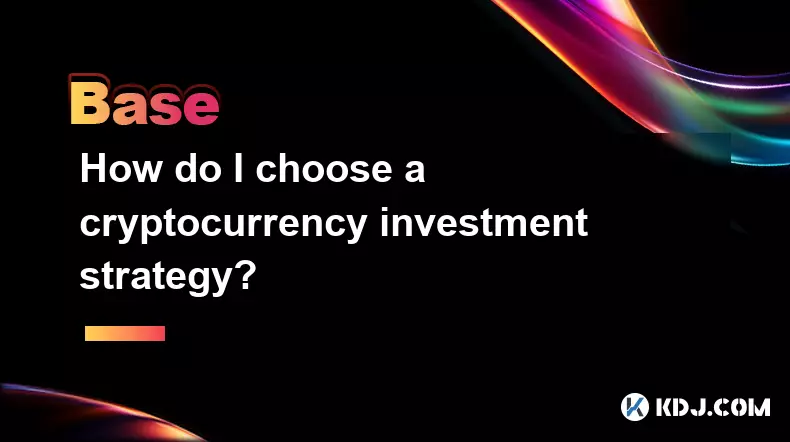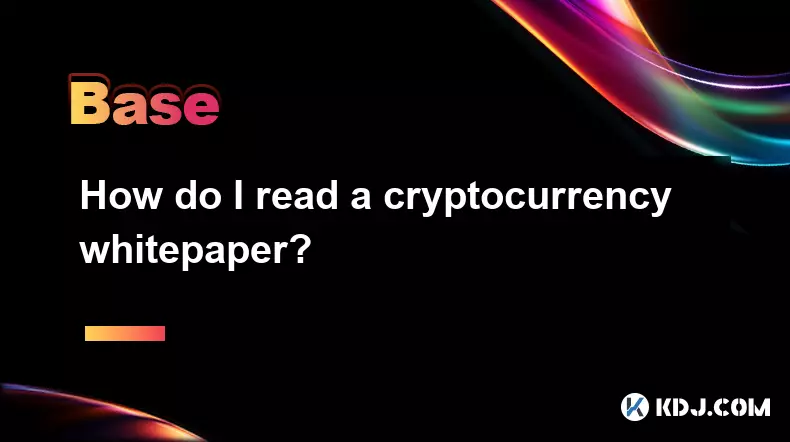-
 bitcoin
bitcoin $122288.232522 USD
0.16% -
 ethereum
ethereum $4480.662914 USD
-0.22% -
 xrp
xrp $2.962747 USD
-2.32% -
 tether
tether $1.000120 USD
-0.05% -
 bnb
bnb $1145.654223 USD
-2.07% -
 solana
solana $227.105217 USD
-1.67% -
 usd-coin
usd-coin $0.999548 USD
-0.02% -
 dogecoin
dogecoin $0.250875 USD
-2.04% -
 tron
tron $0.340654 USD
-0.49% -
 cardano
cardano $0.837968 USD
-2.52% -
 hyperliquid
hyperliquid $48.960449 USD
0.06% -
 chainlink
chainlink $22.049280 USD
-1.33% -
 ethena-usde
ethena-usde $1.000404 USD
0.02% -
 sui
sui $3.586212 USD
0.20% -
 avalanche
avalanche $29.894916 USD
-4.18%
How do I choose a cryptocurrency investment strategy?
Understanding your risk tolerance is crucial in crypto investing—assess how much volatility you can handle, choose strategies that match your profile, and prioritize projects with strong fundamentals over hype.
Sep 27, 2025 at 03:55 pm

Understanding Risk Tolerance in Crypto Investing
1. Assessing personal risk tolerance is a foundational step when entering the cryptocurrency market. Volatility is inherent in digital assets, with prices often swinging dramatically within short timeframes. Investors must determine how much fluctuation they can endure emotionally and financially without making impulsive decisions.
2. Conservative investors may lean toward established cryptocurrencies like Bitcoin or Ethereum, which have demonstrated resilience over multiple market cycles. These assets typically exhibit lower volatility compared to newer altcoins, though they are not immune to sharp corrections.
3. Aggressive investors might allocate portions of their portfolios to emerging projects with high growth potential but elevated risk. These tokens often lack proven track records and can be influenced heavily by speculation, regulatory developments, or technological failures.
4. Diversification plays a key role in aligning investments with risk profiles. Spreading capital across various asset types—such as large-cap cryptos, DeFi tokens, and blockchain infrastructure projects—can mitigate exposure to any single point of failure.
5. Regular reassessment of risk appetite is essential. Life circumstances, financial goals, and market conditions evolve, necessitating periodic adjustments to investment approaches to maintain alignment with one’s comfort level.
Selecting Between Active and Passive Approaches
1. Active trading involves frequent buying and selling based on technical analysis, market sentiment, and macroeconomic indicators. This strategy demands significant time, discipline, and access to real-time data. Traders often use tools like candlestick charts, moving averages, and volume metrics to identify entry and exit points.
2. Passive investing, often referred to as “HODLing,” focuses on long-term ownership of digital assets regardless of short-term price movements. This method suits individuals who believe in the underlying technology and adoption trajectory of specific blockchains over years.
3. Dollar-cost averaging (DCA) is a popular passive technique where investors purchase a fixed amount of a cryptocurrency at regular intervals. This reduces the impact of volatility by spreading purchases over time, avoiding the risk of investing a lump sum at a peak.
4. Hybrid models combine elements of both strategies. An investor might hold a core portfolio passively while allocating a smaller portion for tactical trades during high-volatility events such as protocol upgrades or exchange listings.
5. The choice between active and passive methods should reflect available resources, including time, technical knowledge, and emotional stamina. Misalignment between strategy and capability often leads to suboptimal outcomes.
Evaluating Project Fundamentals and Ecosystems
1. Successful crypto investing requires more than price tracking; it demands deep research into project fundamentals. Key factors include the strength and transparency of the development team, clarity of the whitepaper, and real-world utility of the token within its ecosystem.
2. Blockchain networks with robust developer activity, active community engagement, and consistent updates tend to demonstrate greater longevity. Open-source repositories like GitHub provide insight into coding frequency and collaboration levels.
3. Tokenomics—the structure of supply, distribution, and incentives—must be scrutinized. Projects with excessive pre-mines, opaque vesting schedules, or inflationary mechanisms may pose higher risks to investors.
4. Partnerships with established institutions, integration into decentralized applications, and presence on major exchanges enhance credibility and liquidity. These factors contribute to sustainable demand beyond speculative interest.
Investors should prioritize protocols solving genuine problems rather than chasing trends driven solely by social media hype.Frequently Asked Questions
What is the safest way to start investing in cryptocurrency?Begin with reputable platforms offering strong security measures such as two-factor authentication and cold storage. Start small, focus on well-established coins, and avoid leveraging until gaining experience.
How much of my portfolio should I allocate to crypto?There is no universal rule, but many financial advisors suggest limiting exposure to 5%–10% of total investable assets, depending on individual risk tolerance and overall financial stability.
Can I rely on influencers for investment decisions?Influencers often have undisclosed affiliations or incentives. While they may highlight opportunities, independent verification through primary sources like project documentation and on-chain data is critical.
What tools help monitor my crypto investments effectively?Portfolio trackers like CoinGecko, Delta, or Blockfolio allow users to aggregate holdings across wallets and exchanges. On-chain analytics platforms such as Glassnode or Nansen offer deeper insights into market behavior and holder trends.
Disclaimer:info@kdj.com
The information provided is not trading advice. kdj.com does not assume any responsibility for any investments made based on the information provided in this article. Cryptocurrencies are highly volatile and it is highly recommended that you invest with caution after thorough research!
If you believe that the content used on this website infringes your copyright, please contact us immediately (info@kdj.com) and we will delete it promptly.
- BlockDAG, DOGE, HYPE Sponsorship: Crypto Trends Shaping 2025
- 2025-10-01 00:25:13
- Deutsche Börse and Circle: A StableCoin Adoption Powerhouse in Europe
- 2025-10-01 00:25:13
- BlockDAG's Presale Buzz: Is It the Crypto to Watch in October 2025?
- 2025-10-01 00:30:13
- Bitcoin, Crypto, and IQ: When Genius Meets Digital Gold?
- 2025-10-01 00:30:13
- Stablecoins, American Innovation, and Wallet Tokens: The Next Frontier
- 2025-10-01 00:35:12
- NBU, Coins, and Crypto in Ukraine: A New Yorker's Take
- 2025-10-01 00:45:14
Related knowledge

How does cryptocurrency achieve decentralization?
Sep 30,2025 at 04:37am
Understanding the Foundation of Decentralization in Cryptocurrency1. Cryptocurrency achieves decentralization primarily through the use of blockchain ...

What are some common methods of cryptocurrency market manipulation?
Sep 27,2025 at 02:55am
Wash Trading and Its Impact on Market Perception1. Wash trading involves an individual or entity simultaneously buying and selling the same cryptocurr...

How do I read a cryptocurrency whitepaper?
Sep 27,2025 at 05:54am
Understanding the Structure of a Cryptocurrency Whitepaper1. Begin by identifying the executive summary, which outlines the project’s core vision and ...

Can I recover lost cryptocurrency?
Sep 25,2025 at 08:18am
Understanding the Nature of Cryptocurrency Loss1. Cryptocurrency operates on decentralized networks, meaning there is no central authority to reverse ...

How do I choose a cryptocurrency investment strategy?
Sep 27,2025 at 03:55pm
Understanding Risk Tolerance in Crypto Investing1. Assessing personal risk tolerance is a foundational step when entering the cryptocurrency market. V...

How can I earn passive income from cryptocurrency?
Sep 23,2025 at 10:18am
Staking Cryptocurrencies for Regular Returns1. Many blockchain networks operate on a proof-of-stake (PoS) consensus mechanism, allowing users to earn ...

How does cryptocurrency achieve decentralization?
Sep 30,2025 at 04:37am
Understanding the Foundation of Decentralization in Cryptocurrency1. Cryptocurrency achieves decentralization primarily through the use of blockchain ...

What are some common methods of cryptocurrency market manipulation?
Sep 27,2025 at 02:55am
Wash Trading and Its Impact on Market Perception1. Wash trading involves an individual or entity simultaneously buying and selling the same cryptocurr...

How do I read a cryptocurrency whitepaper?
Sep 27,2025 at 05:54am
Understanding the Structure of a Cryptocurrency Whitepaper1. Begin by identifying the executive summary, which outlines the project’s core vision and ...

Can I recover lost cryptocurrency?
Sep 25,2025 at 08:18am
Understanding the Nature of Cryptocurrency Loss1. Cryptocurrency operates on decentralized networks, meaning there is no central authority to reverse ...

How do I choose a cryptocurrency investment strategy?
Sep 27,2025 at 03:55pm
Understanding Risk Tolerance in Crypto Investing1. Assessing personal risk tolerance is a foundational step when entering the cryptocurrency market. V...

How can I earn passive income from cryptocurrency?
Sep 23,2025 at 10:18am
Staking Cryptocurrencies for Regular Returns1. Many blockchain networks operate on a proof-of-stake (PoS) consensus mechanism, allowing users to earn ...
See all articles










































































